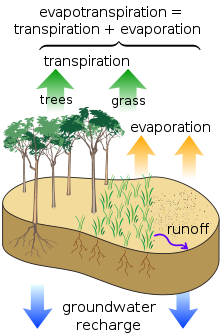- Groundwater recharge
-
Groundwater recharge or deep drainage or deep percolation is a hydrologic process where water moves downward from surface water to groundwater. This process usually occurs in the vadose zone below plant roots and is often expressed as a flux to the water table surface. Recharge occurs both naturally (through the water cycle) and anthropologically (i.e., "artificial groundwater recharge"), where rainwater and or reclaimed water is routed to the subsurface.
Groundwater is recharged naturally by rain and snow melt and to a smaller extent by surface water (rivers and lakes). Recharge may be impeded somewhat by human activities including paving, development, or logging. These activities can result in enhanced surface runoff and reduction in recharge. Use of groundwaters, especially for irrigation, may also lower the water tables. Groundwater recharge is an important process for sustainable groundwater management, since the volume-rate abstracted from an aquifer in the long term should be less than or equal to the volume-rate that is recharged.
Artificial groundwater recharge is becoming increasingly important in India, where over-pumping of groundwater by farmers has led to underground resources becoming depleted. In 2007, on the recommendations of the International Water Management Institute, the Indian government allocated Rs 1800 crore (US$400million) to fund dug-well recharge projects (a dug-well is a wide, shallow well, often lined with concrete) in 100 districts within seven states where water stored in hard-rock aquifers had been over-exploited.
Recharge can help move excess salts that accumulate in the root zone to deeper soil layers, or into the groundwater system. Another environmental issue is the disposal of waste through the water flux such as dairy farms, industrial, and urban runoff.
Contents
Estimation methods
Rates of groundwater recharge are difficult to quantify, since other related processes, such as evaporation, transpiration (or evapotranspiration) and infiltration processes must first be measured or estimated to determine the balance.
Physical
Physical methods use the principles of soil physics to estimate recharge. The direct physical methods are those that attempt to actually measure the volume of water passing below the root zone. Indirect physical methods rely on the measurement or estimation of soil physical parameters, which along with soil physical principles, can be used to estimate the potential or actual recharge. After months without rain the level of the rivers under humid climate is low and represents solely drained groundwater. Thus the recharge can be calculated from this base flow if the catchment area is known.
Chemical
Chemical methods utilize the presence of relatively inert water-soluble substances, such as an isotopic tracer or chloride,[1] moving through the soil, as deep drainage occurs.
Numerical models
Recharge can be estimated using numerical methods, using such codes as HELP, UNSAT-H, SHAW, WEAP, and MIKE SHE. The 1D-program HYDRUS1D is available online. These codes generally use climate and soil data to arrive at a recharge estimate, and use Richards equation in some form to model groundwater flow in the vadose zone.
Ground water recharge
Wetlands help maintain the level of the water table and exert control on the hydraulic head (O'Brien 1988; Winter 1988). This provides force for ground water recharge and discharge to other waters as well. The extent of ground water recharge by a wetland is dependent upon soil, vegetation, site, perimeter to volume ratio, and water table gradient (Carter and Novitzki 1988; Weller 1981). Ground water recharge occurs through mineral soils found primarily around the edges of wetlands (Verry and Timmons 1982) The soil under most wetlands is relatively impermeable. A high perimeter to volume ratio, such as in small wetlands, means that the surface area through which water can infiltrate into the ground water is high (Weller 1981). Ground water recharge is typical in small wetlands such as prairie potholes, which can contribute significantly to recharge of regional ground water resources (Weller 1981). Researchers have discovered ground water recharge of up to 20% of wetland volume per season (Weller 1981).
See also
- Depression focused recharge
- Drainage
- Infiltration (hydrology)
- Hydrology (agriculture)
- Soil salinity control by subsurface drainage
- Watertable control
- Category: Water conservation
References
- ^ Allison, G.B.; Hughes, M.W. (1978). "The use of environmental chloride and tritium to estimate total recharge to an unconfined aquifer". Australian Journal of Soil Research 16 (2): 181–195. doi:10.1071/SR9780181.
- Allison, G.B.; Gee, G.W.; Tyler, S.W. (1994). "Vadose-zone techniques for estimating groundwater recharge in arid and semiarid regions". Soil Science Society of America Journal 58: 6–14. doi:10.2136/sssaj1994.03615995005800010002x. OSTI 7113326.
- Bond, W.J. (1998). Soil Physical Methods for Estimating Recharge. Melbourne: CSIRO Publishing.
Further reading
- LaMoreaux, Philip E., & Tanner, Judy T, ed (2001). Springs and bottled water of the world: Ancient history, source, occurrence, quality and use. Berlin, Heidelberg, New York: Springer-Verlag. ISBN 3-540-61841-4. http://books.google.com/?id=sjEoBmfUka0C&printsec=frontcover&dq=springs+bottled&q. Retrieved 13 July 2010 Provides a good overview of hydrogeological processes, including groundwater recharge.
- Pierre D. Glynn & L. Niel Plummer (March 2005). "Geochemistry and the understanding of ground-water systems". Hydrogeology Journal 13 (1): 263–287. doi:10.1007/s10040-004-0429-y. https://es.ucmerced.edu/Past_Seminars/2008-fall-es-seminar-material/Glynn-Plummer2005.pdf. Retrieved 4 July 2010
Categories:- Aquifers
- Hydrology
- Land management
- Soil physics
- Sustainable environmental design
- Sustainable gardening
- Sustainable technologies
- Water
- Water and the environment
- Water conservation
- Water resources management
Wikimedia Foundation. 2010.

